With a skyrocketing growth of video content on such platforms as YouTube, TikTok, Instagram, and Reels, it is evident that we are in a video-first era. Nevertheless, a very intriguing question is still being discussed in creative forums: "Is video editing dead?"
However, this question has been spread all over by the quick development of AI, which represents doubt, but not the fact. The truth is that video editing will not be gone; it will be transformed. This article elaborates on the ways AI revolutionizes video editing tasks, what the most innovative technologies will have on both new and mature creators.
Today, creators upload 500 minutes of video every second (only on YouTube), inundating platforms with a never-ending flow of visual content. The role of the video editor in a highly saturated environment is no longer only about cutting clips or adding transitions—it is turning into a creative director supported by AI.
Video editors must become much faster, tell much more interesting stories, and be out in the crowd. The Wondershare Filmora is going in this direction, offering intelligent automation to the video editor without loss of creative freedom, making not only survival, but also success possible.
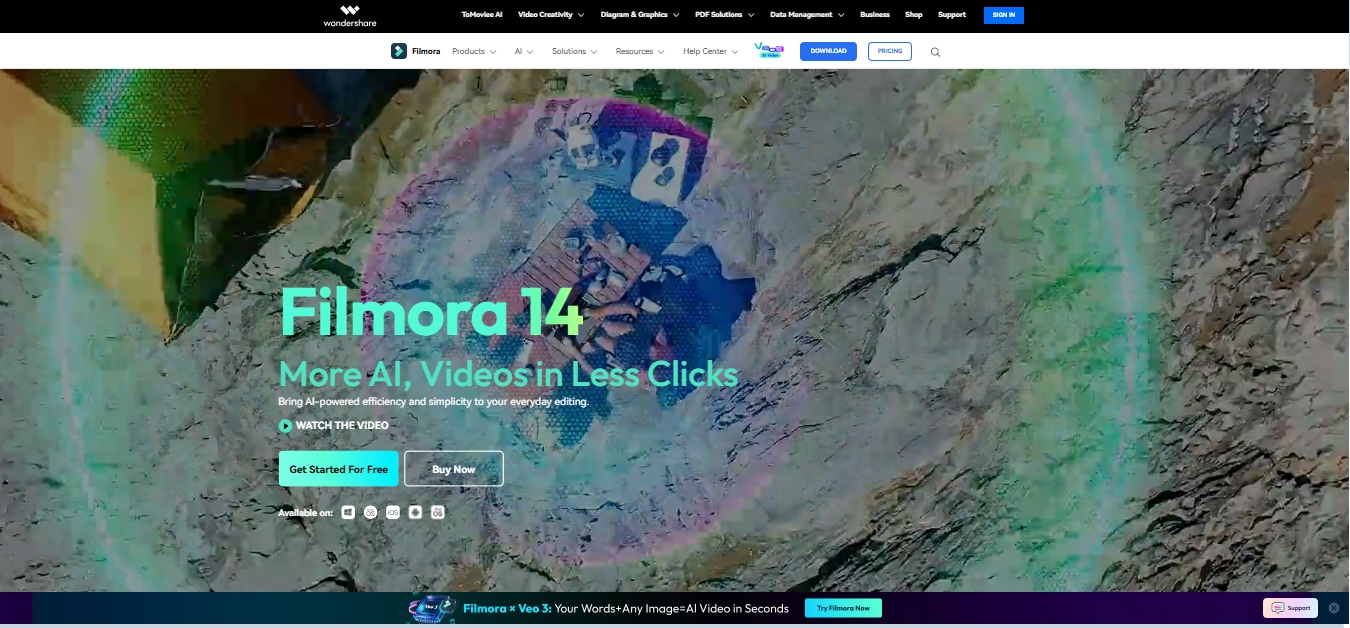
Table of Contents
Part 1. The Evolution of Video Editing: From Linear Tapes to AI Co-Pilots
It was once dominated by linear tape editing and complex timelines in tools like Adobe Premiere Pro; video editing was a painstaking, manual craft. These traditional workflows still exist—but are increasingly reserved for cinematic productions and high-budget film work.
Nowadays, most creators have noticed that their editing landscape has been completely changed by three converging forces:
- Content demand explosion: Short-form videos are preferred by 73% of consumers to learn about products, therefore brands are under a lot of pressure to create more content—they have to make sure each video is made with a specific platform in mind, such as Instagram Reels, TikTok, and YouTube Shorts.
- AI democratization: No more hours of fine-tuning as the same task can be done in seconds. AI-powered tools automate color correction, audio cleanup, subtitle generation, background music syncing, and even rough cuts. These smart assistants' free creators from technical burdens, letting them focus on storytelling.
- The attention economy: Viewers choose in the initial 3 seconds if they will stay or go. This has changed the emphasis of editing from slow-paced to quickly paced, visually interesting, and emotionally impactful storytelling—needing both creativity and efficient work processes.
Part 2. Major Trends Shaping the Future of Video Editing
AI-powered automation
AI-based automation is revolutionizing video editing in a way that it is more rapid, intuitive, and creative. In addition to just assisting, the tools now go deeper; they are akin to the editor. Features such as automatic scene detection, voice-to-text subtitles, and smart reframing facilitate task management, while object removal and auto-captioning ensure that the content is compatible with various platforms. Through Generative AI, editors can generate B-roll from prompts (e.g., "sunset over Tokyo") or implement visual changes by issuing commands. Predictive editing is an emotional tone analyzer that suggests the cuts, transitions, and music—thereby it helps both the speed and the narrating impact.
Example:
Wondershare Filmora is a notable instance of AI-based automation that gets these technologies accomplished with a simple and user-friendly interface. Some of its AI tools are:
- Smart Scene Cut: It is an innovative technology that automatically divides the video into shorter clips that are more suitable for sharing on social media.
- AI Copywriting + AI Mate: ChatGPT-powered script generation and real-time editing help creators write convincing stories.
- AI Video Enhancer & Denoise: Efficiency at a single click—brighten dark footage, go up to 4K, or get audio clean as a studio.
- AI Object Removal & Lip Sync: If you have an AI tool like this, then it is also very easy to get rid of the unwanted parts or make the translation and synchronization seamless.
Cloud-Based Collaborative Editing
AI today is enabling video editors to play a more creative role—less of a manual cutting job and more of reshaping the story. It has not substituted the editors, rather it is assisting them to become creative directors who instruct the visual, emotional aspects, and a video. However, to remain competitive, editors have to master new skills such as prompt writing, data handling, and making content suitable for different platforms. This change is also the beginning of some interesting new career avenues such as creating AI avatars, personalized marketing videos, and live-streaming shopping content.
Example:
Wondershare Filmora Workspace is the solution to this problem as well as a simple and efficient cloud-based environment for today's creators. It gives an option to use and save up-to-date files across different platforms, have a history of assets and settings automatically, keeps files safe with encryption, and easily understand each other's feedback by jointly watching video frame by frame. Since Filmora Workspace has integrated cloud media management and sharing features, it is no longer a problem to collaborate on the work, make changes, and deliver—whether you are in the studio or on the other side of the world.
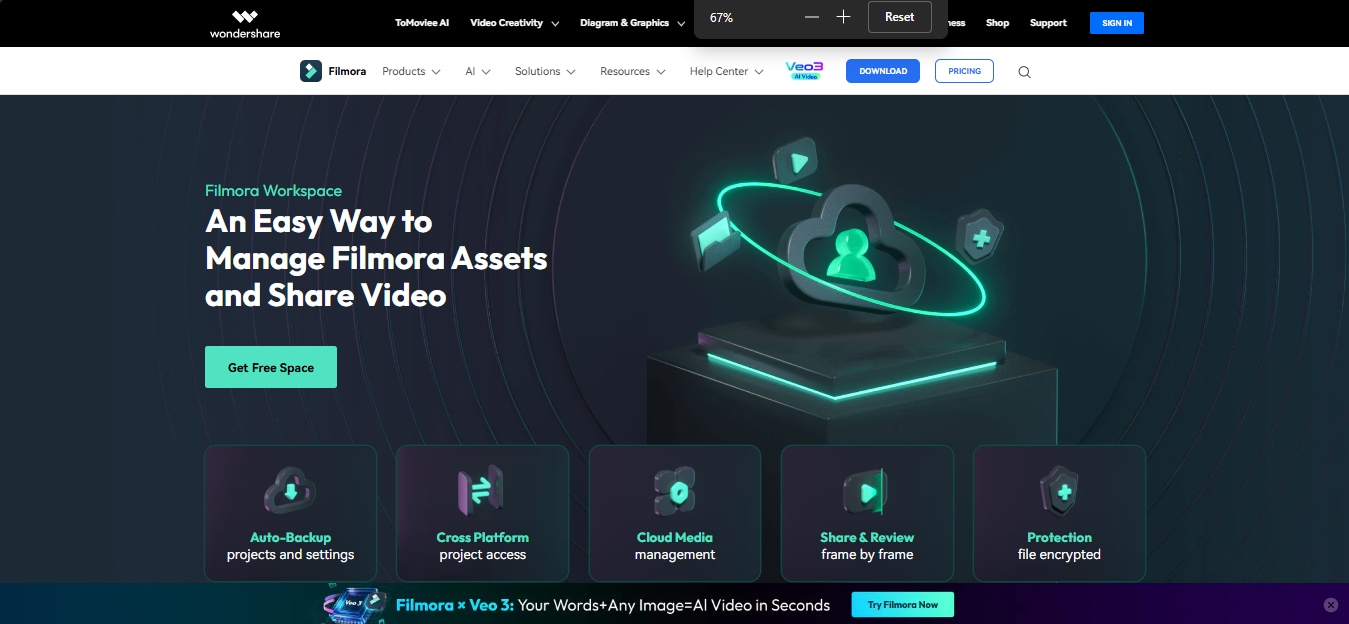
Mobile-First & Social-First Editing
The dominance of vertical video (9:16) and short-form content is having a profound influence on the nature of the editing process.
- For instance, creators now need editing tools that are usable while they are on the move and have an export format that is compatible with Instagram Reels, TikTok, YouTube Shorts, and other platforms.
- Moreover, they cannot do without instant cutdowns, resizing, and platform-optimized captions.
Filmora makes mobile and social exports easier with features like Smart Short Clips, vertical video templates, and auto-resizing, ensuring content is ready to publish without reformatting.
Template-Driven Creativity
Template-driven creativity is now transforming video production methods, facilitating the ease of design skills, and at the same time not compromising the speed and polish of production. With the increase in the need for consistent, professional-looking content across platforms, creators find themselves turning to drag-and-drop templates, animated elements, and AI-assisted layouts to simplify their workflows.
For example, a product promo, vlog intro, tutorial, or social ad, these ready-made assets can even help beginners to produce studio-grade videos in minutes.
Example:
Wondershare Filmora jumps on this bandwagon through its powerful Asset Center, a one-stop creative library that is filled with over 2.9 million themed assets such as 13,000+ effects, 39,000+ animated titles, 300,000+ royalty-free music tracks (from partners like Universal Music), and 1.5 million stock media footage.
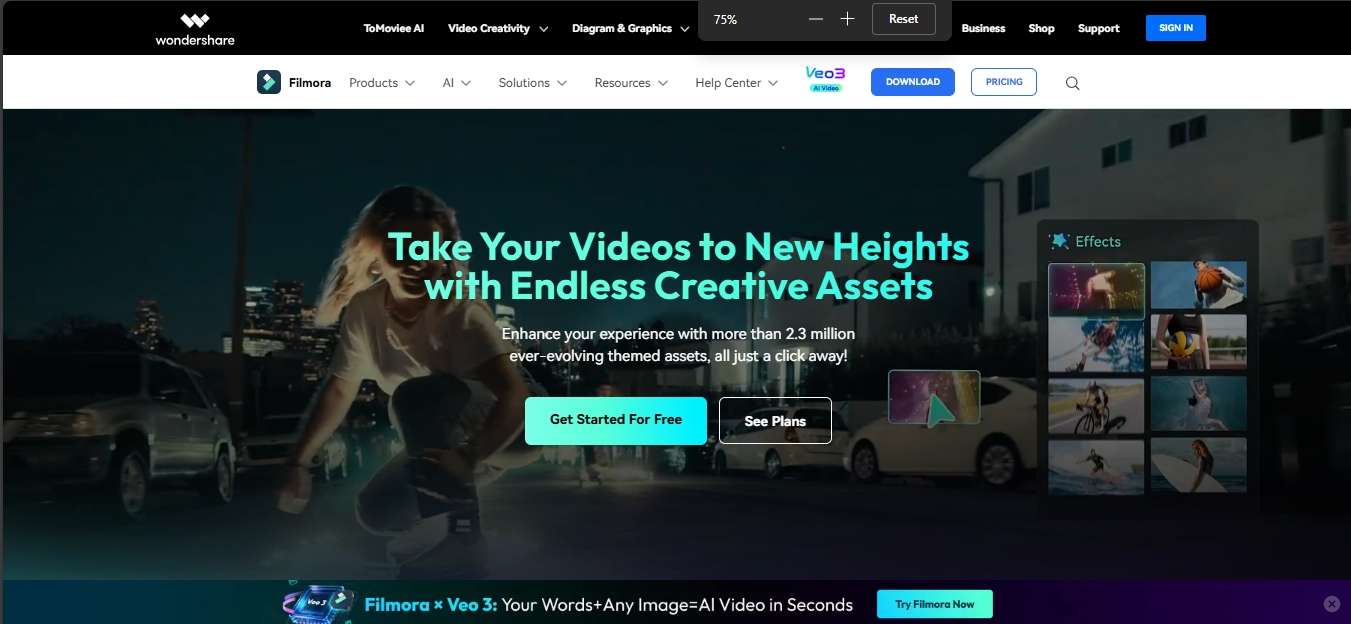
Generative AI & the Rise of "Text to Video"
Generative AI has revolutionized video making by providing prompt-based tools that allow users to create visually rendered video scenes just by using text. This is a huge leap in storytelling, it not only saves a lot of time but also opens possibilities for people from different walks of life to easily create content of a higher quality e.g. from marketers to educators and casual creators.
Furthermore, Filmora's Text to Video feature has been equipped with Veo3 technology that automatically converts written ideas into video sequences, hence, massively cutting down the time for production and making it easier for creators to enter.
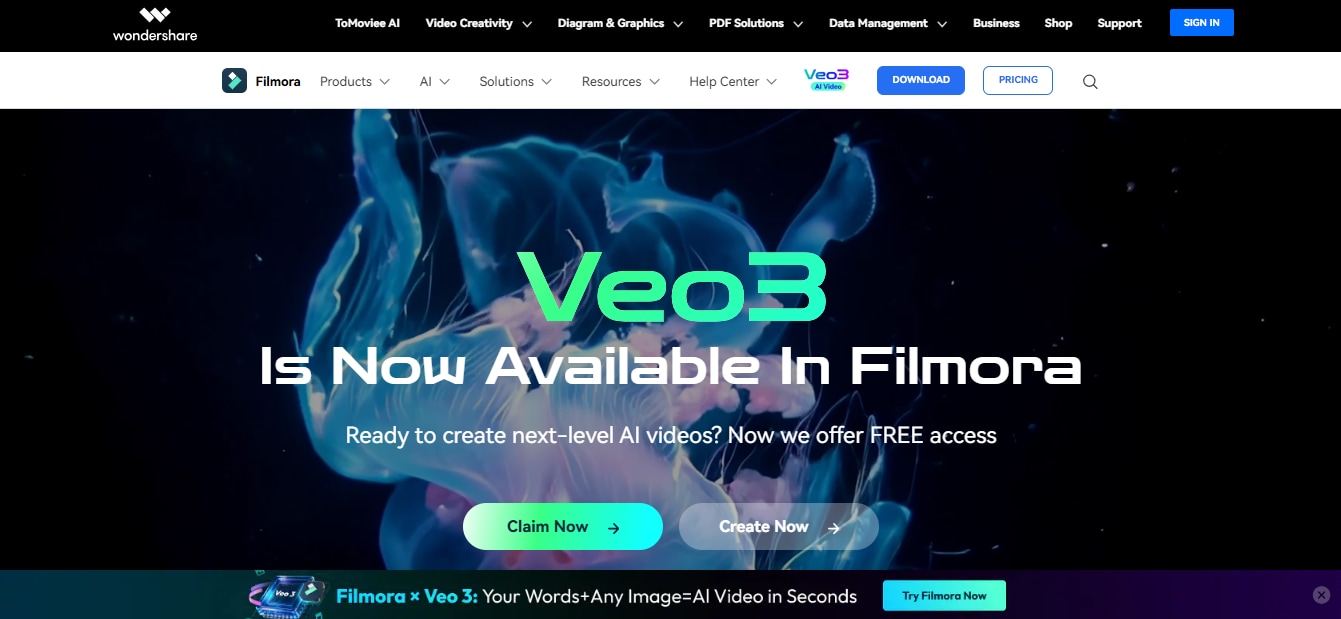
Immersive & Interactive Experiences
The line that separates reality from virtual is getting thinner with VR and AR applications that are becoming a norm in the video editing industry. Filmora is tailored to be perfectly compatible with 360° video capturing thus enabling creators and brands to easily produce immersive content. A few examples of such technology include using virtual changing rooms for online shopping or making panoramic travel vlogs. Moreover, the AI-driven personalization empowers the creators to introduce the audience's specific parts, like names, places, and preferences, they become highly targeted thus maximizing the engagement with the videos at the scale.
The Rise of Synthetic Media
Using virtual humans and voices, artificial intelligence in synthetic media—AI-generated stuff—influences brands, educators, and creators beyond words. AI avatars, especially, are going to replace human presenters; they can speak 50+ languages and thus become very strong training, marketing, and engagement tools for the whole world.
Example:
Filmora is on board with the concept of future and therefore created The Virtual Avatar Presenter that allows you to get up to 3D Characters without having to master the complicated skills of performance. Their avatars can be of great value not only to teachers in online-learning platforms but also to the sales team during presentations, since Filmora avatars are engagement and personalization boosters.
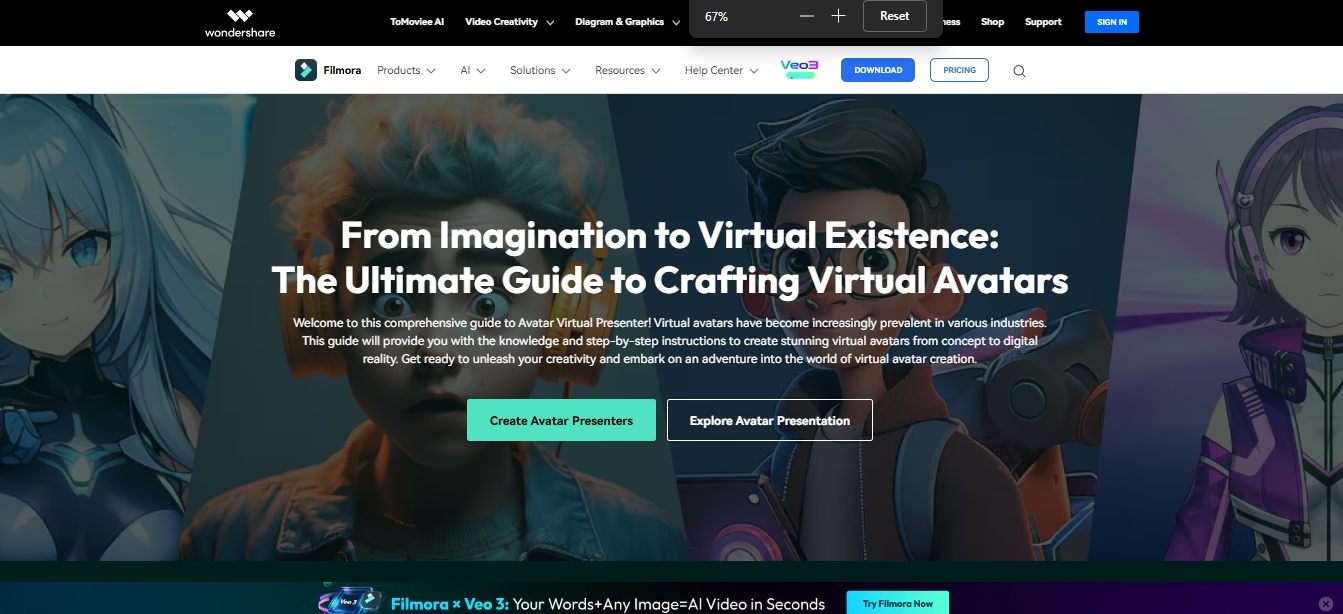
Part 3. How AI Reshapes Editor Roles (Not Replaces Them)
- AI does not take away the jobs of editors; rather, it changes them into creative directors who are empowered to decide the outputs, make the story better, and add the emotional part.
- Prompt engineering, data literacy, and cross-platform storytelling are some of the new skills that are becoming indispensable for today's editors.
- AI is the driving force behind new jobs such as the creation of user-generated content, live shopping and more.
Part 4. The Future Toolkit: What's Next?
Chat-based editing
The process of video editing is turning out to be as easy as conversing with an assistant. You just write commands like "Remove background and add jazz soundtrack," and AI does all the necessary work instantly.
Real-time collaboration
Because of AI agents that are built into cloud-based editors, teams that are in different parts of the world can co-edit the same video without any problems. The AI keeps track of the changes, synchronizes the timelines, and even solves problems in real-time. It certainly raises the level of productivity for the brands, the creators, and the agencies.
8K + AI optimization
With the ever-increasing demand for content, AI-powered tools can now upscale the 4K footage to 8K and at the same time, reduce the rendering time drastically.
Part 5. How Wondershare Filmora Embodies the Future
Wondershare Filmora is not only following the trail of video editing but also leading it. With an extensively growing suite of AI-powered tools and platform-optimized resources, Filmora is the game-changer of professional, viral, and visually appealing content creation. In what ways:
AI-powered efficiency
Filmora's AI video editor is the most efficient video editor, whose automatic functions free you from doing the boring work. You can utilize AI-powered tools such as Smart Scene Cut, AI Copywriting, AI Video Enhancer, and more to provide a script, detect key visuals, upscale footage to 4K, and improve audio/video in just one interaction.
Platform-specific templates
Filmora offers over 3,000 premade templates that perfectly suit TikTok, YouTube Shorts, Instagram, and other platforms. Whether you're going to compose a wedding scene, an educational guide, a news flash, or a business promo, Filmora's dynamic templates exist in each category.
Ethical AI tools
Filmora is an ethical AI user, which is the relationship between watermarking for AI-generated assets and copyright-safe libraries provided by the company. Your music, Universal Music for Creators, gives you both the unlimited commercial and copyright-free library of 300,000 songs and 2,300,000 curated royalty-free assets of everything you can imagine: photos, videos, stickers, and effects.
Democratized pro features
Filmora embodies the concept of democratization of pro features by providing journalists access to liquid animations and AI facial mosaics. Its AI Portrait Cutout, Voice Cloning, Dynamic Subtitles, and Smart Masking tools make it possible for non-professionals—no matter their skills—to create professional videos with an added cinematic flair.
Preparing for 2026 and Beyond: An Action Plan
- To remain relevant, editors must learn prompt engineering and AI workflows and also improve their storytelling fundamentals. The combination of tech fluency and creative intuition will be the main factor.
- Specializing in general skills is not good enough in a saturated market. Pay more attention to high-demand areas like VR editing or AI avatar direction to gain authority and be different.
- Leverage smart tools like Filmora to do technical tasks automatically—captioning, silences, color grading—thus freeing time for your creative vision and storytelling.
- Reveal your AI use, watermark synthetic assets, and respect user data. Transparent and responsible editing will gain audience trust for a long time.
Conclusion
Videographers' future does not lie in substitution but reinvention. AI generative is revolutionizing the video editors' work, enabling them to create stories quicker, more accessible, and more personalized. Wondershare Filmora is a leading example that AI-powered features such as text editing, silence auto-cut, instant captioning, and smart color grading are delivered at the highest level. It gives editors—both novices and experienced ones—the opportunity to concentrate on their creativity, while the tool takes care of tedious tasks. As the year 2026 approaches, editors who are proficient in AI tools like Filmora, and those who focus on new niches, as well as those who abide by the ethical standards, will be at the top of the digital storytelling game. A video editor of the future is not replaced—they are being re-imagined.



 100% Security Verified | No Subscription Required | No Malware
100% Security Verified | No Subscription Required | No Malware

